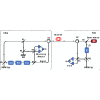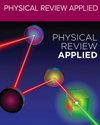Source monitoring for plug-and-play continuous-variable quantum key distribution
IF 3.8
2区 物理与天体物理
Q2 PHYSICS, APPLIED
引用次数: 0
Abstract
Continuous-variable quantum key distribution (CV-QKD) with plug-and-play design offers a promising route in simplifying the system implementation and shows intriguing prospects for quantum access network applications. However, such a scheme makes it possible for the eavesdropper (Eve) to completely control the source, helping her to gain more information since the laser travels through the unsecured channel before being modulated, which will severely compromise the performance of the system and limit its potential application. To fight against the security loophole, we propose a passive source monitoring scheme based on a combination of beam splitter and homodyne detector, as well as source noise suppression. The corresponding entanglement-based model is established to estimate the secret key rate for the proposed scheme. We show that the performance of the plug-and-play CV-QKD system can be significantly improved by using the source monitoring scheme compared with the untrusted source model. With typical parameters, the maximum transmission distance can be promoted by more than 50%, and the secret key rate can be increased by more than 25% when the transmission distance is longer than 50 km. This study provides a feasible approach for improving the security and performance of the plug-and-play CV-QKD and holds positive potential for practical applications.

即插即用连续可变量子密钥分发的源监控
采用即插即用设计的连续可变量子密钥分配(CV-QKD)为简化系统实现提供了一条大有可为的途径,并为量子接入网络应用展示了令人感兴趣的前景。然而,这种方案使得窃听者(夏娃)有可能完全控制光源,帮助她获得更多信息,因为激光在被调制前会通过不安全的信道,这将严重影响系统的性能,限制其潜在应用。为了弥补这一安全漏洞,我们提出了一种基于分光镜和同调探测器组合以及源噪声抑制的被动源监控方案。我们建立了相应的基于纠缠的模型来估算所提方案的秘钥率。我们的研究表明,与不信任源模型相比,使用源监控方案可以显著提高即插即用 CV-QKD 系统的性能。在典型参数下,最大传输距离可提高 50%以上,当传输距离超过 50 km 时,密钥率可提高 25%以上。这项研究为提高即插即用 CV-QKD 的安全性和性能提供了一种可行的方法,具有积极的实际应用潜力。
本文章由计算机程序翻译,如有差异,请以英文原文为准。
求助全文
约1分钟内获得全文
求助全文
来源期刊

Physical Review Applied
PHYSICS, APPLIED-
CiteScore
7.80
自引率
8.70%
发文量
760
审稿时长
2.5 months
期刊介绍:
Physical Review Applied (PRApplied) publishes high-quality papers that bridge the gap between engineering and physics, and between current and future technologies. PRApplied welcomes papers from both the engineering and physics communities, in academia and industry.
PRApplied focuses on topics including:
Biophysics, bioelectronics, and biomedical engineering,
Device physics,
Electronics,
Technology to harvest, store, and transmit energy, focusing on renewable energy technologies,
Geophysics and space science,
Industrial physics,
Magnetism and spintronics,
Metamaterials,
Microfluidics,
Nonlinear dynamics and pattern formation in natural or manufactured systems,
Nanoscience and nanotechnology,
Optics, optoelectronics, photonics, and photonic devices,
Quantum information processing, both algorithms and hardware,
Soft matter physics, including granular and complex fluids and active matter.
 求助内容:
求助内容: 应助结果提醒方式:
应助结果提醒方式:


